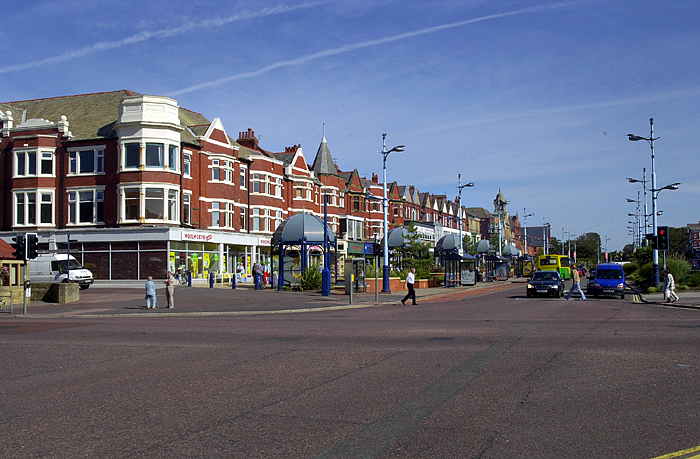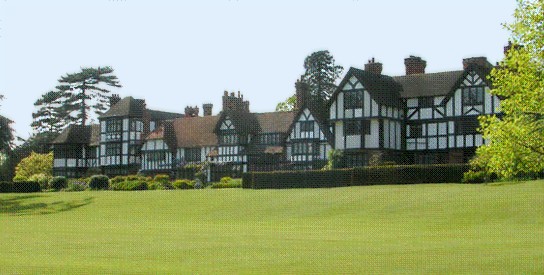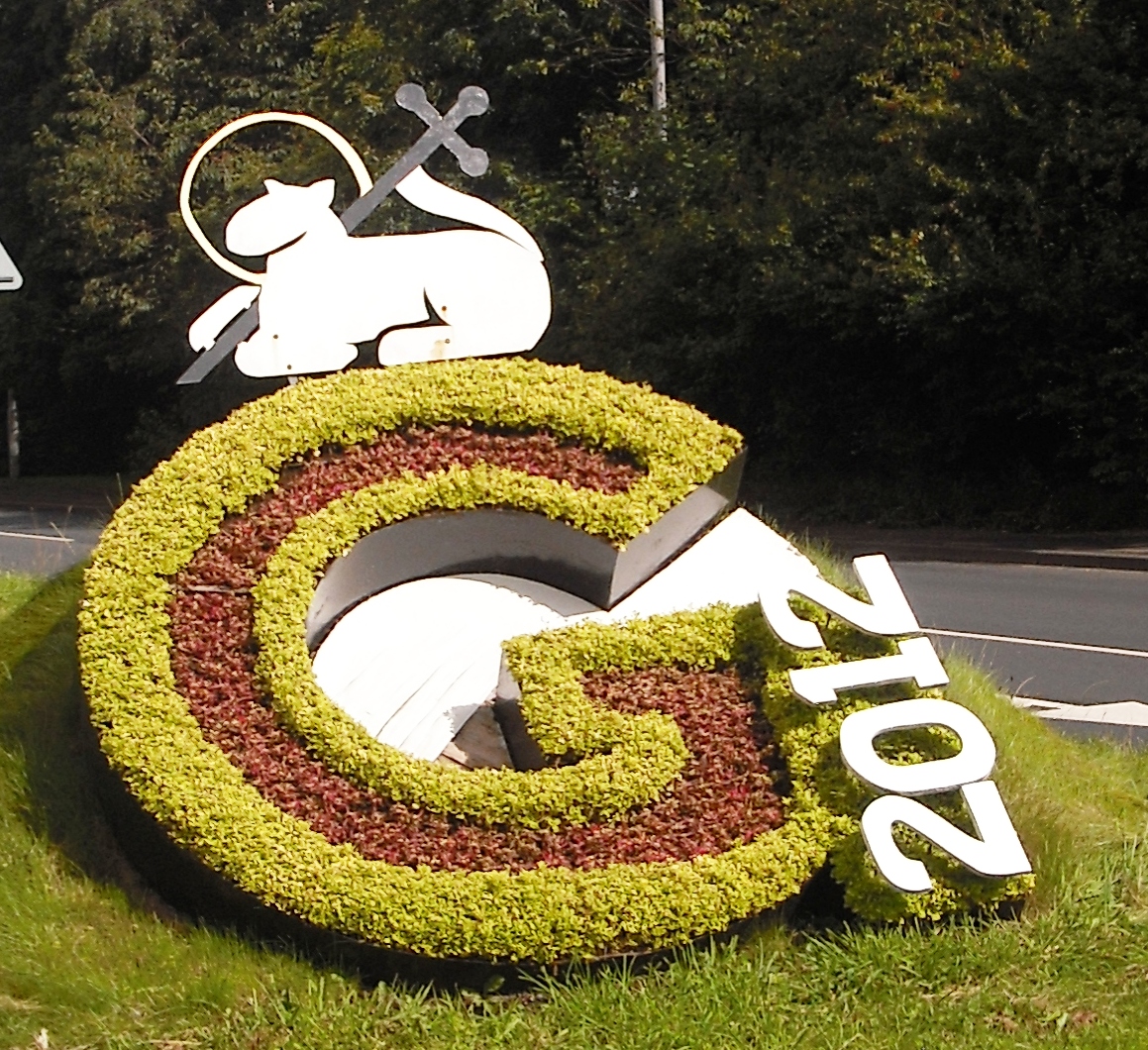|
St Anne's Pier
St Anne's Pier is a Victorian era pleasure pier in the English seaside resort of St Anne's-on-the-Sea, Lancashire. It lies on the estuary of the River Ribble. The pier, designed by Alfred Dowson, was completed in 1885 and was one of the earliest public buildings in St Anne's, a 19th-century planned town. The pier was originally intended to be a sedate promenading venue for the resort's visitors, but attractions were later added. Changes made to the estuary channels to improve access to Preston Dock left the pier on dry land and ended its steamer services to Blackpool and Liverpool. A Tudor-style entrance was built in 1899. Early 20th-century additions included a Moorish-style pavilion in 1904 and the Floral Hall in 1910. The Moorish Pavilion was destroyed by fire in 1974, shortly after the town's centenary; the Floral Hall burned down in 1982. Originally long, the pier was reduced to by the demolition of the seaward end. English Heritage has designated the pier a Grade II ... [...More Info...] [...Related Items...] OR: [Wikipedia] [Google] [Baidu] |
St Anne's-on-the-Sea
Lytham St Annes () is a seaside town in the Borough of Fylde in Lancashire, England. It is on the Fylde coast, directly south of Blackpool on the Ribble Estuary. The population at the 2011 census was 42,954. The town is almost contiguous with Blackpool but is separated from it by Blackpool Airport. The town is made up of the four areas of Lytham, Ansdell, Fairhaven and St Annes-on-Sea. Lytham St Annes has four golf courses and links, the most notable being the Royal Lytham & St Annes Golf Club, which regularly hosts the Open Championship. Lytham St Annes is a reasonably affluent area with residents' earnings among the highest in the North of England. Towns and districts Lytham St Annes consists of four main areas: Lytham, Saint Anne's-on-the-Sea, Ansdell and Fairhaven. Lytham The name Lytham comes from the Old English ''hlithum,'' plural of ''hlith'' meaning (place at) the slopes'.'' The Green, a strip of grass running between the shore and the main coastal road, is a ... [...More Info...] [...Related Items...] OR: [Wikipedia] [Google] [Baidu] |
Frederick Stanley, 16th Earl Of Derby
Frederick Arthur Stanley, 16th Earl of Derby, (15 January 1841 – 14 June 1908) styled as Hon. Frederick Stanley from 1844 to 1886 and as The Lord Stanley of Preston between 1886 and 1893, was a Conservative Party politician in the United Kingdom who served as Colonial Secretary from 1885 to 1886 and Governor General of Canada from 1888 to 1893. An avid sportsman, he built Stanley House Stables in England and is famous in North America for presenting Canada with the Stanley Cup. Stanley was also one of the original inductees of the Hockey Hall of Fame. Background and education Stanley was the second son of Prime Minister Edward Smith-Stanley, 14th Earl of Derby, and the Hon. Emma Caroline, daughter of Edward Bootle-Wilbraham, 1st Baron Skelmersdale. He was born in London, and educated at Eton and Sandhurst. He received a commission in the Grenadier Guards, rising to the rank of Captain before leaving the army for politics.''Burke's'', 'Derby'. [...More Info...] [...Related Items...] OR: [Wikipedia] [Google] [Baidu] |
George Formby
George Formby, (born George Hoy Booth; 26 May 1904 – 6 March 1961) was an English actor, singer-songwriter and comedian who became known to a worldwide audience through his films of the 1930s and 1940s. On stage, screen and record he sang light, comic songs, usually playing the ukulele or banjolele, and became the UK's highest-paid entertainer. Born in Wigan, Lancashire, he was the son of George Formby Sr, from whom he later took his stage name. After an early career as a stable boy and jockey, Formby took to the music hall stage after the early death of his father in 1921. His early performances were taken exclusively from his father's act, including the same songs, jokes and characters. In 1923 he made two career-changing decisions – he purchased a ukulele, and married Beryl Ingham, a fellow performer who became his manager and transformed his act. She insisted that he appear on stage formally dressed, and introduced the ukulele to his performance. He started ... [...More Info...] [...Related Items...] OR: [Wikipedia] [Google] [Baidu] |
Russ Conway
Russ Conway, DSM (born Trevor Herbert Stanford; 2 September 1925 – 16 November 2000) was an English popular music pianist and composer. Conway had 20 piano instrumentals in the UK Singles Chart between 1957 and 1963, including two number one hits. Career Conway was born in Bristol, England.Larkin C (1997) ''Virgin Encyclopedia of Sixties Music'', Muze UK Ltd, p. 125 He won a scholarship to Bristol Cathedral Choir School and, after leaving school at 14, was largely self-taught on piano during a three-year term in a Borstal detention centre for stealing from his employers. During the Second World War, he was conscripted into the Royal Navy and was awarded the Distinguished Service Medal as signalman in a minesweeping flotilla "for distinguished service, efficiency and zeal" in clearance of mines in the Aegean and operations during the relief of Greece 1944–45. During his Navy service, he lost the tip of the third finger of his right hand while using a bread slicer. A ... [...More Info...] [...Related Items...] OR: [Wikipedia] [Google] [Baidu] |
Leslie Henson
Leslie Lincoln Henson (3 August 1891 – 2 December 1957) was an English comedian, actor, producer for films and theatre, and film director. He initially worked in silent films and Edwardian musical comedy and became a popular music hall comedian who enjoyed a long stage career. He was famous for his bulging eyes, malleable face and raspy voice and helped to form the Entertainments National Service Association (ENSA) during the Second World War. Born in Notting Hill, London, Henson became interested in the theatre from an early age, writing and producing theatrical pieces while at school. He studied with the Cairns James School of Musical and Dramatic Art as a child, making his professional stage début at the age of 19. His first West End role was in ''Nicely, Thanks!'' (1912) and he later starred in several hit West End Edwardian musical comedies, including '' To-Night's the Night'' (1915) and ''Yes, Uncle!'' (1917). After briefly serving with the Royal Flying Corps, he was ... [...More Info...] [...Related Items...] OR: [Wikipedia] [Google] [Baidu] |
Gracie Fields
Dame Gracie Fields (born Grace Stansfield; 9 January 189827 September 1979) was an English actress, singer, comedian and star of cinema and music hall who was one of the top ten film stars in Britain during the 1930s and was considered the highest paid film star in the world in 1937. She was known affectionately as ''Our Gracie'' and ''the Lancashire Lass'' and for never losing her strong, native Lancashire accent. She was appointed a Commander of the Order of the British Empire (CBE) and an Officer of the Venerable Order of St John (OStJ) in 1938, and a Dame Commander of the Order of the British Empire (DBE) in 1979. Life and work Early life Fields was born Grace Stansfield, a daughter of Frederick Stansfield (1874–1956) and his wife Sarah Jane 'Jenny' Stansfield née Bamford (1879–1953), over a fish and chip shop owned by her grandmother, Sarah Bamford, in Molesworth Street, Rochdale, Lancashire. Her great-grandfather, William Stansfield (b.1805), of Hebden Bridge ... [...More Info...] [...Related Items...] OR: [Wikipedia] [Google] [Baidu] |
Music Hall
Music hall is a type of British theatrical entertainment that was popular from the early Victorian era, beginning around 1850. It faded away after 1918 as the halls Rebranding, rebranded their entertainment as Variety show, variety. Perceptions of a distinction in Britain between bold and scandalous ''Music Hall'' and subsequent, more respectable ''Variety show, Variety'' differ. Music hall involved a mixture of popular songs, comedy, #Speciality acts, speciality acts, and variety entertainment. The term is derived from a type of theatre or venue in which such entertainment took place. In North America vaudeville was in some ways analogous to British music hall, featuring rousing songs and comic acts. Originating in Bar (establishment), saloon bars within public houses during the 1830s, music hall entertainment became increasingly popular with audiences. So much so, that during the 1850s some public houses were demolished, and specialised music hall theatres developed in their ... [...More Info...] [...Related Items...] OR: [Wikipedia] [Google] [Baidu] |
Winter Garden
A winter garden is a kind of garden maintained in wintertime. History The origin of the winter garden dates back to the 17th to 19th centuries where European nobility would construct large conservatories that would house tropical and subtropical plants and would act as an extension of their living space. Many of these would be attached to their main palaces. Earlier versions would be constructed of masonry with large windows and a glass roof, usually in the Classical or Gothic styles. While in the 19th century many of these conservatories were made out of iron and curvilinear glass. Winter gardens were not just restricted to private residence, many were built for the greater public. The first large public winter garden was built in 1842–46 in Regent's Park, and was used for evening occasions, large flower shows and social gatherings.Kohlmaier, Georg. Houses of Glass: A Nineteenth-Century Building Type. The MIT Press. Cambridge MA. 1991. Other winter gardens, such as the ... [...More Info...] [...Related Items...] OR: [Wikipedia] [Google] [Baidu] |
Timber Framing
Timber framing (german: Holzfachwerk) and "post-and-beam" construction are traditional methods of building with heavy timbers, creating structures using squared-off and carefully fitted and joined timbers with joints secured by large wooden pegs. If the structural frame of load-bearing timber is left exposed on the exterior of the building it may be referred to as half-timbered, and in many cases the infill between timbers will be used for decorative effect. The country most known for this kind of architecture is Germany, where timber-framed houses are spread all over the country. The method comes from working directly from logs and trees rather than pre-cut dimensional lumber. Hewing this with broadaxes, adzes, and draw knives and using hand-powered braces and augers (brace and bit) and other woodworking tools, artisans or framers could gradually assemble a building. Since this building method has been used for thousands of years in many parts of the world, many st ... [...More Info...] [...Related Items...] OR: [Wikipedia] [Google] [Baidu] |
Mock Tudor
Tudor Revival architecture (also known as mock Tudor in the UK) first manifested itself in domestic architecture in the United Kingdom in the latter half of the 19th century. Based on revival of aspects that were perceived as Tudor architecture, in reality it usually took the style of English vernacular architecture of the Middle Ages that had survived into the Tudor period. The style later became an influence elsewhere, especially the British colonies. For example, in New Zealand, the architect Francis Petre adapted the style for the local climate. In Singapore, then a British colony, architects such as R. A. J. Bidwell pioneered what became known as the Black and White House. The earliest examples of the style originate with the works of such eminent architects as Norman Shaw and George Devey, in what at the time was considered Neo-Tudor design. Tudorbethan is a subset of Tudor Revival architecture that eliminated some of the more complex aspects of Jacobethan in favour of ... [...More Info...] [...Related Items...] OR: [Wikipedia] [Google] [Baidu] |
Preston, Lancashire
Preston () is a city on the north bank of the River Ribble in Lancashire, England. The city is the administrative centre of the county of Lancashire and the wider City of Preston, Lancashire, City of Preston local government district. Preston and its surrounding district obtained City status in the United Kingdom, city status in 2002, becoming England's 50th city in the 50th year of Elizabeth II of the United Kingdom, Queen Elizabeth II's reign. Preston has a population of 114,300, the City of Preston district 132,000 and the Preston Built-up Area 313,322. The Preston Travel To Work Area, in 2011, had a population of 420,661, compared with 354,000 in the previous census. Preston and its surrounding area have provided evidence of ancient Roman Britain, Roman activity, largely in the form of a Roman road that led to a camp at Walton-le-Dale. The Angles established Preston; its name is derived from the Old English meaning "priest's settlement" and in the ''Domesday Book'' is reco ... [...More Info...] [...Related Items...] OR: [Wikipedia] [Google] [Baidu] |
Liverpool
Liverpool is a City status in the United Kingdom, city and metropolitan borough in Merseyside, England. With a population of in 2019, it is the List of English districts by population, 10th largest English district by population and its ESPON metropolitan areas in the United Kingdom, metropolitan area is the fifth largest in the United Kingdom, with a population of 2.24 million. On the eastern side of the Mersey Estuary, Liverpool historically lay within the ancient Hundred (county division), hundred of West Derby (hundred), West Derby in the county of Lancashire. It became a Borough status in the United Kingdom, borough in 1207, a City status in the United Kingdom, city in 1880, and a county borough independent of the newly-created Lancashire County Council in 1889. Its Port of Liverpool, growth as a major port was paralleled by the expansion of the city throughout the Industrial Revolution. Along with general cargo, freight, and raw materials such as coal and cotton ... [...More Info...] [...Related Items...] OR: [Wikipedia] [Google] [Baidu] |







